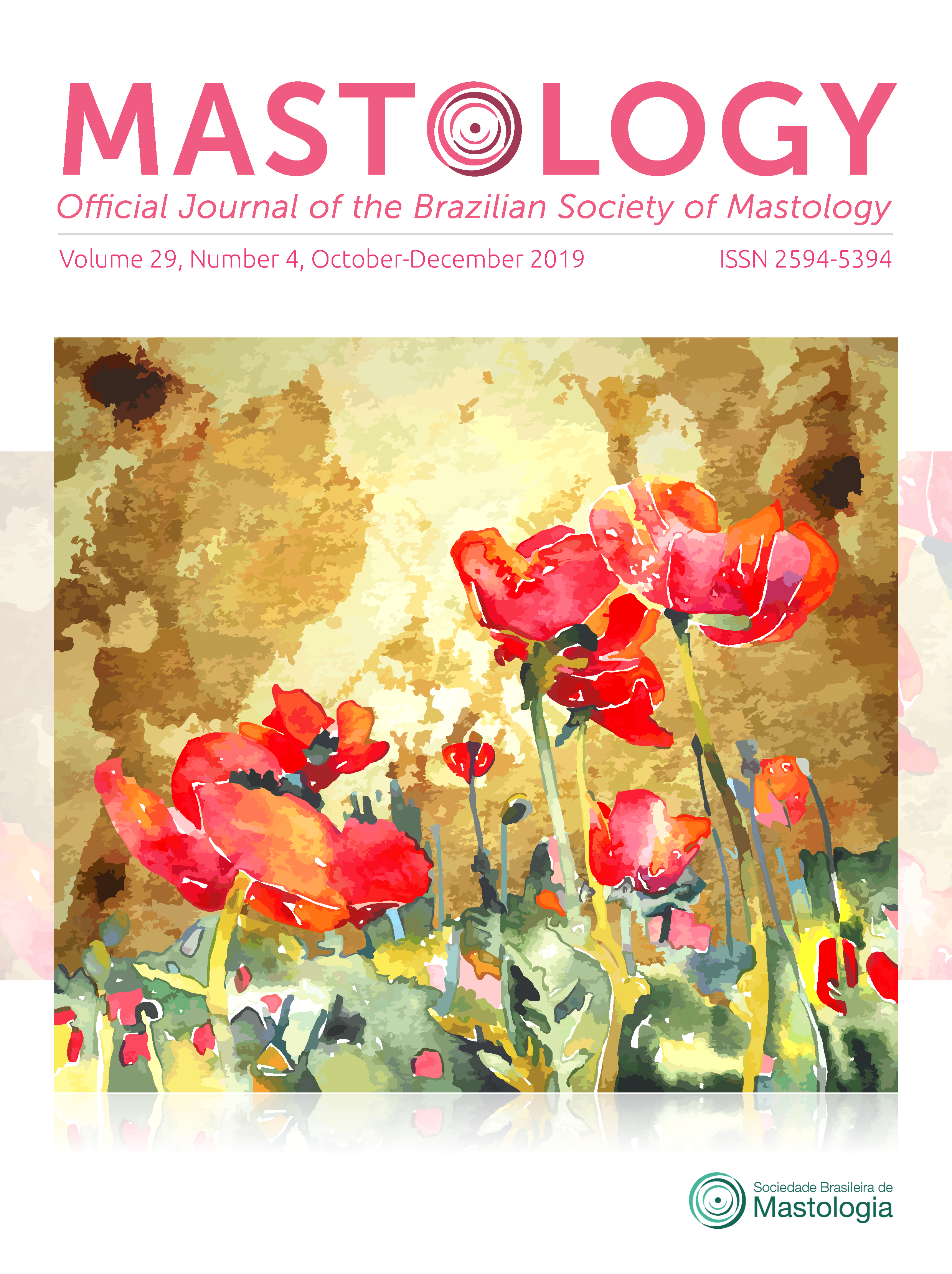THE IMPLEMENTATION OF PATIENT NAVIGATION TO IMPROVE MAMMOGRAPHY COVERAGE AND ACCESS TO BREAST CANCER CARE IN RIO DE JANEIRO
Keywords:
breast neoplasms, mammography, patient navigation, primary health careAbstract
This study evaluates the Patient Navigation Program (Programa de Navegação do Paciente - PNP), which was introduced to a community in the municipality of Rio de Janeiro. The objectives were: to establish the viability of the PNP in this context; identify barriers to mammogram screening; and ensure mammogram coverage for 70% of women recruited between 50 and 69 years old. From March to September 2018, 678 women with an average age of 58 years old were recruited from the Andaraí community. Follow-up was performed through the patient browser (PB), by telephone, email and text messages. Twelve percent of women refused to participate in the PNP for cultural reasons. The main barriers reported by women were: systematic problems with health care programming (100%), financial problems (64%), concerns about communicating with medical staff (58%), fear (44%), and social support (14%). The PNP obtained 100% satisfaction, and the mammogram coverage rate goal was exceeded, reaching 88%. The PN promoted an increase in the rate for mammogram coverage, aided in the transmission of quality information, reduced individuals’ fear of mammography, and facilitated access to breast health care.
Downloads
References
Instituto Nacional de Cancer Jose Alencar Gomes da Silva. Estimativa 2018: Incidencia de cancer no Brasil [Internet]. Brasil: INCA; 2018 [acessado em 3 abr. 2019]. Disponivel em: https://www.inca.gov.br/sites/ufu.sti.inca.local/files//media/document//estimativa-incidencia-de-cancer-nobrasil-2018.pdf
Richards MA, Westcombe AM, Love SB, Littlejohns P, Ramirez AJ. Influence of delay on survival in patients with breast cancer: A systematic review. Lancet. 1999;353(9159):1119-26. https://doi.org/10.1016/s0140-6736(99)02143-1
Unger-Saldana K. Challenges to the early diagnosis and treatment of breast cancer in developing countries. World J Clin Oncol. 2014;5(3):465-77. https://doi.org/10.5306/wjco.v5.i3.465
Goss PE, Lee BL, Badovinac-Crnjevic T, Strasser-Weippl K, Chavarri-Guerra Y, St Louis J, et al. Planning cancer control in Latin America and the Caribbean. Lancet Oncol. 2013;14(5):391-436. https://doi.org/10.1016/S1470-2045(13)70048-2
Rezende MC, Koch HA, Figueiredo J de A, Thuler LCS. Factors leading to delay in obtaining definitive diagnosis of suspicious lesions for breast cancer in a dedicated health unit in Rio de Janeiro [in Portuguese]. Rev Bras Ginecol Obstet. 2009;31(2):75- 81. http://dx.doi.org/10.1590/S0100-72032009000200005
Medeiros GC, Bergmann A, Aguiar SS, Thuler LCS. Determinants of the time between breast cancer diagnosis and initiation of treatment in Brazilian women [in Portuguese]. Cad Saude Publica. 2015;31(6):1269-82. http://dx.doi.org/10.1590/0102-311X00048514
Barros AF, Uemura G, de Macedo JL. Interval for access to treatment for breast cancer in the Federal District, Brazil [in Portuguese]. Rev Bras Ginecol Obstet. 2013;35(10):458-63. http://dx.doi.org/10.1590/S0100-72032013001000006
Anderson BO, Yip CH, Smith RA, Shyyan R, Sener SF, Eniu A, et al. Guideline implementation for breast healthcare in low-income and middle-income countries: Overview of the Breast Health Global Initiative Global Summit 2007. Cancer. 2008;113(Supl. 8):2221-43. https://doi.org/10.1002/cncr.23844
Lee BL, Liedke PE, Barrios CH, Simon SD, Finkelstein DM, Goss PE. Breast cancer in Brazil: Present status and future goals. Lancet Oncol. 2012;13(3):e95-e102. https://doi.org/10.1016/S1470-2045(11)70323-0
Marinho LAB, Cecatti JG, Osis MJD, Gurgel MSC. Knowledge, attitude and practice of mammography among women users of public health services. Rev Saude Publica. 2008;42(2):200-7. http://dx.doi.org/10.1590/S0034-89102008005000006
Oliveira EXG, Pinheiro RS, Melo ECP, Carvalho MS. Condicionantes socioeconomicos e geograficos do acesso a mamografia no Brasil, 2003-2008. Cienc Saude Coletiva. 2011;16(9):3649-64. http://dx.doi.org/10.1590/S1413-81232011001000002
Kuschnir R, Chorny AH. Redes de atencao a saude: contextualizando o debate. Cienc Saude Coletiva. 2010;15(5):2307- 16. http://dx.doi.org/10.1590/S1413-81232010000500006
Brasil. Ministerio da Saude. Portaria no 1.101, de 12 de junho de 2002. Estabelece os parametros de cobertura assistencial no ambito do Sistema Unico de Saude – SUS. Diario Oficial da Republica Federativa do Brasil. 2002; Secao 1:36.
Freitas-Junior R, Rodrigues DCN, Correa RS, Peixoto JE, Oliveira HVCG, Rahal RMS. Contribuicao do Sistema Unico de Saude no rastreamento mamografico no Brasil, 2013. Radiol Bras. 2016;49(5):305-10. http://dx.doi.org/10.1590/0100-3984.2014.0129
World Health Organization. International Agency for Research on Cancer. World Cancer Report 2008. Lyon: World Health Organization; 2008.
Battaglia TA, Bak SM, Heeren T, Chen CA, Kalish R, Tringale S, et al. Boston Patient Navigation Research Program: The impact of navigation on time to diagnostic resolution after abnormal cancer screening. Cancer Epidemiol Biomarkers Prev. 2012;21(10):1645- 54. https://doi.org/10.1158/1055-9965.EPI-12-0532
Bukowski A, Gioia S, Chavarri-Guerra Y, Soto-Perez-de-Celis E, St. Louis J, Nogueira-Rodrigues A, et al. Patient Navigation to Improve Access to Breast Cancer Care in Brazil. J Glob Oncol. 2016;3(5):433-7. https://doi.org/10.1200/JGO.2016.006726
Harford J, Azavedo E, Fischietto M. Guideline Implementation for Breast Healthcare in Low- and Middle-Income Countries. Cancer. 2008;113(Suppl. 8):2282-96.http://doi.org/10.1002/cncr.23841
Freeman HP. Patient navigation: A community-centered approach to reducing cancer mortality. J Cancer Educ. 2006;21(Supl. 1):S11-S14. https://doi.org/10.1207/s15430154jce2101s_4
Freund KM, Battaglia TA, Calhoun E, Darnell JS, Dudley DJ, Fiscella K, et al. Impact of patient navigation on timely cancer care: The Patient Navigation Research Program. J Natl Cancer Inst. 2014;106(6):dju115. https://doi.org/10.1093/jnci/dju115
Jabson JM. Treatment summaries, follow-up care instructions, and patient navigation: Could they be combined to improve cancer survivor’s receipt of follow-up care? J Cancer Surviv. 2015;9(4):692-8. https://doi.org/10.1007/s11764-015-0444-0
Raich PC, Whitley EM, Thorland W, Valverde P, Fairclough D. Patient navigation improves cancer diagnostic resolution: An individually randomized clinical trial in an underserved population. Cancer Epidemiol Biomarkers Prev. 2012;21(10):1629- 38. https://doi.org/10.1158/1055-9965.EPI-12-0513
Percac-Lima S, Lopez L, Ashburner JM, Green AR, Atlas SJ. The longitudinal impact of patient navigation on equity in colorectal cancer screening in a large primary care network. Cancer. 2014;120(13):2025-31. https://doi.org/10.1002/cncr.28682
Ohl ICB, Ohl RIB, Chavaglia SRR, Goldman RE. Public actions for control of breast cancer in Brazil: integrative review. Rev Bras Enferm. 2016;69(4):746-55. http://dx.doi.org/10.1590/0034-7167.2016690424i
Gioia S. Why is breast cancer early detection important? Mastology. 2017;27(3):173-5. http://dx.doi.org/10.5327/Z259453942017EDIT273
Downloads
Published
How to Cite
Issue
Section
License
Copyright (c) 2019 Sandra Gioia, Lucia Brigagão, Cristiane Torres, Alessandra de Lima, Marcelle Medeiros

This work is licensed under a Creative Commons Attribution 4.0 International License.







